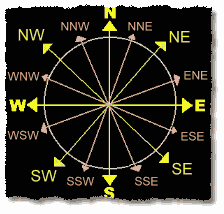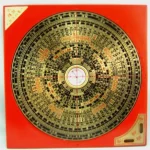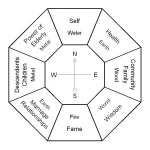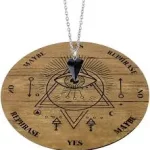Colțurile unei camere pot fi o reprezentare puternică a energiei chi.
Fiecărei direcții de busolă i se atribuie unul dintre cele cinci elemente folosite în feng shui. Introduceți elemente adecvate în funcție de sectorul în care se află dormitorul dvs.
De exemplu, dacă dormitorul este în sectorul de sud – adăugarea unui element de lumânare ajută la susținerea elementului de foc din sectorul de sud.
Sectoarele și elementele asociate acestora includ:
- Nord (apă): mobilier metalic, obiecte sau rame de fotografii
- Sud (foc): lămpi, lumânări sau șemineu
- Est și Sud-Est (Lemn): mobilier, podele sau obiecte din lemn
- Vest și Nord-Vest (Metal): mobilier metalic, obiecte sau rame de fotografii
- Sud-vest și nord-est (Pământ): ceramică, podea cu gresie sau cristale
Colțuri definite de Feng Shui clasic
Fiecare cameră are colțuri care pot fi activate în funcție de tipul de feng shui pe care alegi să îl urmezi.
Feng Shui clasic folosește direcțiile busolei pentru a determina plasarea bagua. O citire a busolei este luată de la ușa din față a casei pentru direcția cu fața pentru a determina plasarea bagua.
Feng shui bagua constă din bucăți în formă de plăcintă numite trigrame și denumite în mod obișnuit sectoare. Un colț în feng shui se referă de obicei la colțul unei camere individuale sau la colțul exterior al casei.
Oricare dintre cele opt direcții ale busolei poate guverna colțurile unei camere, în funcție de direcția de orientare a casei. Următoarele oferă fiecare direcție și zona de viață pe care o guvernează.
- Sud: noroc pentru recunoaștere și faimă
- Sud-vest: dragoste și noroc în relație
- Vest: Noroc descendenților
- Nord-vest: noroc de mentor
- Nord: noroc în carieră
- Nord-est: noroc în educație
- Est: noroc de sănătate
- Sud-est: noroc de bogăție

Cum se folosește o busolă simplă pentru Feng Shui?
O busolă poate fi folosită în multe moduri, de la a spune care este direcția nordului până la găsirea comorilor ascunse sau urmărirea unei căi nemarcate pe un teren sălbatic. Există patru puncte cardinale pe o busolă – nord, sud, est și vest. Pe lângă acestea, o busolă are patru puncte intercardinale și opt puncte intercardinale secundare.
Deoarece este nevoie de direcții mai precise, cercul feței unei busole este împărțit în 360 de mărci numite grade.
Cum să citiți o busolă
- Ține-ți busola ferm în mână, astfel încât placa de bază să fie la nivel și săgeata pentru direcția de deplasare să fie îndreptată direct spre tine.
- Țineți-l la jumătatea distanței dintre față și talie într-o poziție confortabilă a brațului, cu cotul îndoit și busola ținută aproape de stomac.
- Uită-te în jos la busolă și vezi unde îndreaptă acul
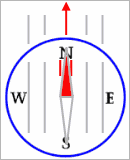
- Întoarce-ți corpul în timp ce ține busola în fața ta.
- Rețineți că pe măsură ce busola se rotește, acul rămâne îndreptat în aceeași direcție.
- Continuați să vă întoarceți până când acul indică spre est pe busolă, ca în imaginea de mai jos, păstrând săgeata de direcție de mers și marcajul de nord îndreptate drept în fața dvs.
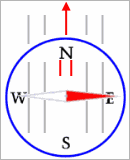
- Pentru a-mi găsi direcția, trebuie să rotesc cadranul busolei până când marcajul de nord și „Săgeata de orientare” sunt aliniate cu capătul nordic al acului. Apoi pot citi titlul care se află în punctul indicatorului de index (capul săgeții direcției de deplasare). Deoarece săgeata de orientare este de obicei două linii paralele pe podeaua carcasei busolei, un lucru bun de memorat este: „ROȘU ÎN ȘOPARA”. Acum știm că ne îndreptăm cu adevărat spre vest (270 de grade).
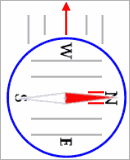
Orice busolă poate fi folosită în Feng Shui, deși doar pentru unele sarcini mici, cum ar fi găsirea colțului camerei care indică o anumită direcție.
